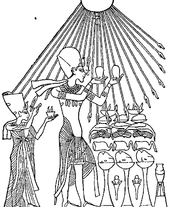Solar symbol

A solar symbol is a symbol representing the Sun. Common solar symbols include circles (with or without rays), crosses, and spirals. In religious iconography, personifications of the Sun or solar attributes are indicated by means of a halo or a radiate crown.
When the systematic study of comparative mythology first became popular in the 19th century, scholarly opinion tended to over-interpret historical myths and iconography in terms of "solar symbolism". This was especially the case with Max Müller and his followers beginning in the 1860s in the context of Indo-European studies.[1] Many "solar symbols" claimed in the 19th century, such as the swastika, triskele, Sun cross, etc. have tended to be interpreted more conservatively in scholarship since the later 20th century.[2]
Solar disk[]

The basic element of most solar symbols is the circular solar disk.
The disk can be modified in various ways, notably by adding rays (found in the Bronze Age in Egyptian depictions of Aten) or a cross. In the ancient Near East, the solar disk could also be modified by addition of the Uraeus (rearing cobra), and in ancient Mesopotamia it was shown with wings.
Bronze Age writing[]
Egyptian hieroglyphs have a large inventory of solar symbolism because of the central position of solar deities (Ra, Horus, Aten etc.) in ancient Egyptian religion.
| |
| |
The "Sun" ideogram in early Chinese writing, beginning with the oracle bone script (c. 12th century BC) also shows the solar disk with a central dot (analogous to the Egyptian hieroglyph); this character later evolved to have a different shape (modern 日).
Astronomical symbol[]
| ☉ | |
|---|---|
Sun | |
| In Unicode | U+2609 ☉ SUN (HTML ☉) |
| Related | |
| See also | U+2600 ☀ BLACK SUN WITH RAYS (HTML ☀)U+263C ☼ WHITE SUN WITH RAYS (HTML ☼) |
| Different from | |
| Different from | U+2299 ⊙ CIRCLED DOT OPERATOR (HTML ⊙ · ⊙, ⊙) |
The modern astronomical symbol for the Sun (a circled dot) was first used in the Renaissance. A diagram in Johannes Kamateros' 12th century Compendium of Astrology shows the Sun represented by a circle with a ray.[3] Bianchini's planisphere, produced in the 2nd century,[4] has a circlet with rays radiating from it.[5]
Rayed depictions[]
A circular disk with alternating triangular and wavy rays emanating from it is a frequent symbol or artistic depiction of the sun.
Antiquity[]
The ancient Mesopotamian "star of Shamash" could be represented with either eight wavy rays, or with four wavy and four triangular rays.
The Vergina Sun (also known as the Star of Vergina, Macedonian Star, or Argead Star) is a rayed solar symbol appearing in ancient Greek art from the 6th to 2nd centuries BC. The Vergina Sun appears in art variously with sixteen, twelve, or eight triangular rays.
Sun with face[]


The iconographic tradition of depicting the Sun with rays and with a human face developed in Western tradition in the high medieval period and became widespread in the Renaissance, harking back to the Sun god (Sol/Helios) wearing a radiate crown in classical antiquity.
Sunburst[]
The sunburst was the badge of king Edward III of England, and has thus become the badge of office of Windsor Herald.
Modern emblems[]
Official insignia which incorporate rayed solar symbols include the Jesuit emblem, the flag of Uruguay, the flag of Kiribati, some versions of the flag of Argentina, the Irish Defence Forces cap badge, and the 1959–1965 coat of arms of Iraq.
The depictions of the sun on the flags of the Republic of China (Taiwan), Kazakhstan, Kurdistan, and Nepal have only straight (triangular) rays; that of Kyrgyzstan has only curvy rays; while that of the Philippines has short diverging rays grouped into threes.
Another rayed form of the sun has simple radial lines dividing the background into two colors, as in the military flags of Japan and the current flag of North Macedonia, and in the top parts of the flags of Tibet and Arizona.
The flag of New Mexico is based on the Zia sun symbol which has four groups of four parallel rays emanating symmetrically from a central circle.
Modern pictogram[]

The modern pictogram representing the Sun as a circle with rays, often eight in number (indicated by either straight lines or triangles; Unicode Miscellaneous Symbols ☀ U+2600; ☼ U+263C) indicates "clear weather" in weather forecasts, originally in television forecasts in the 1970s.[7] The Unicode 6.0 Miscellaneous Symbols and Pictographs block introduced another set of weather pictograms, including "white sun" without rays 1F323
